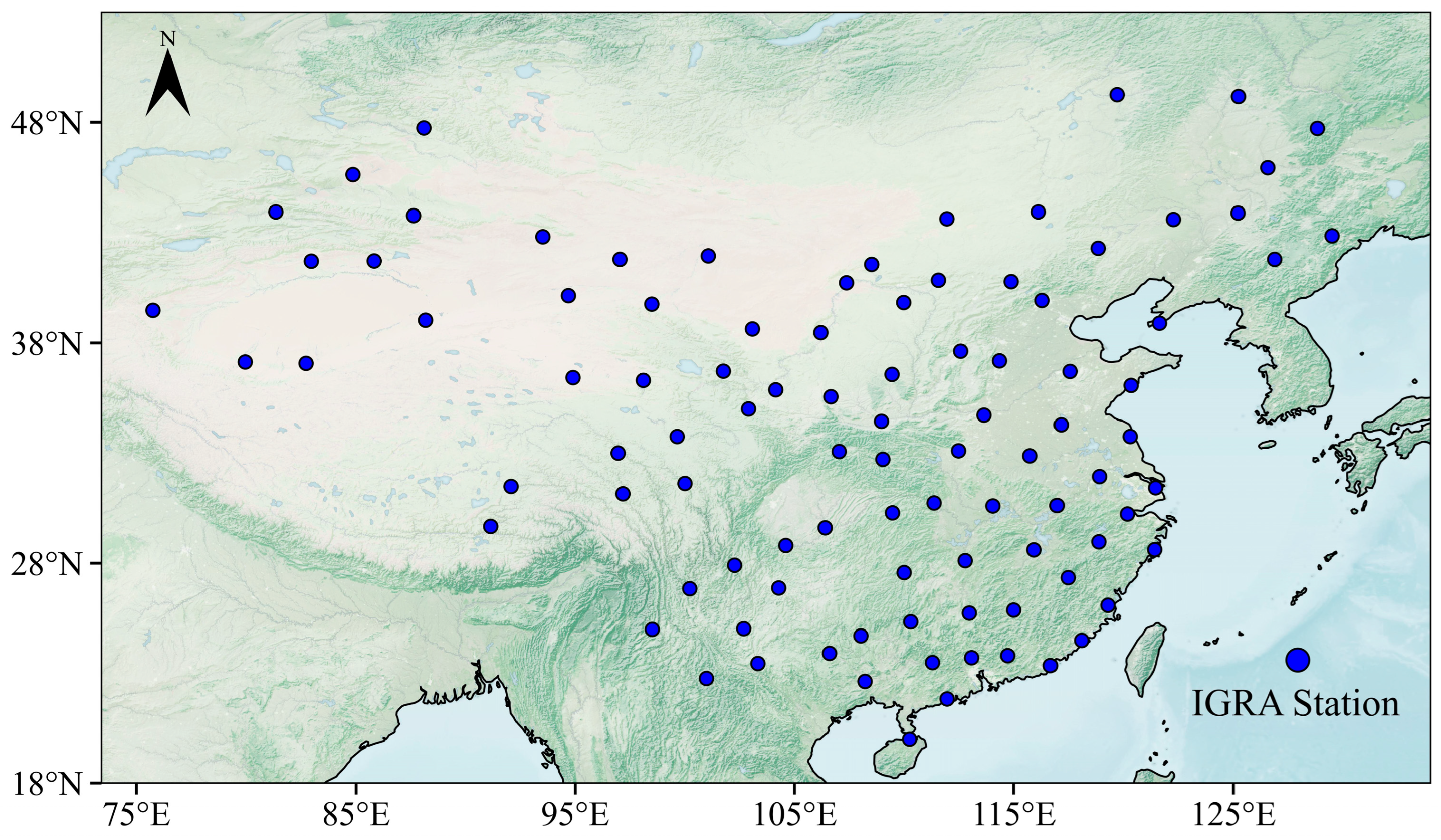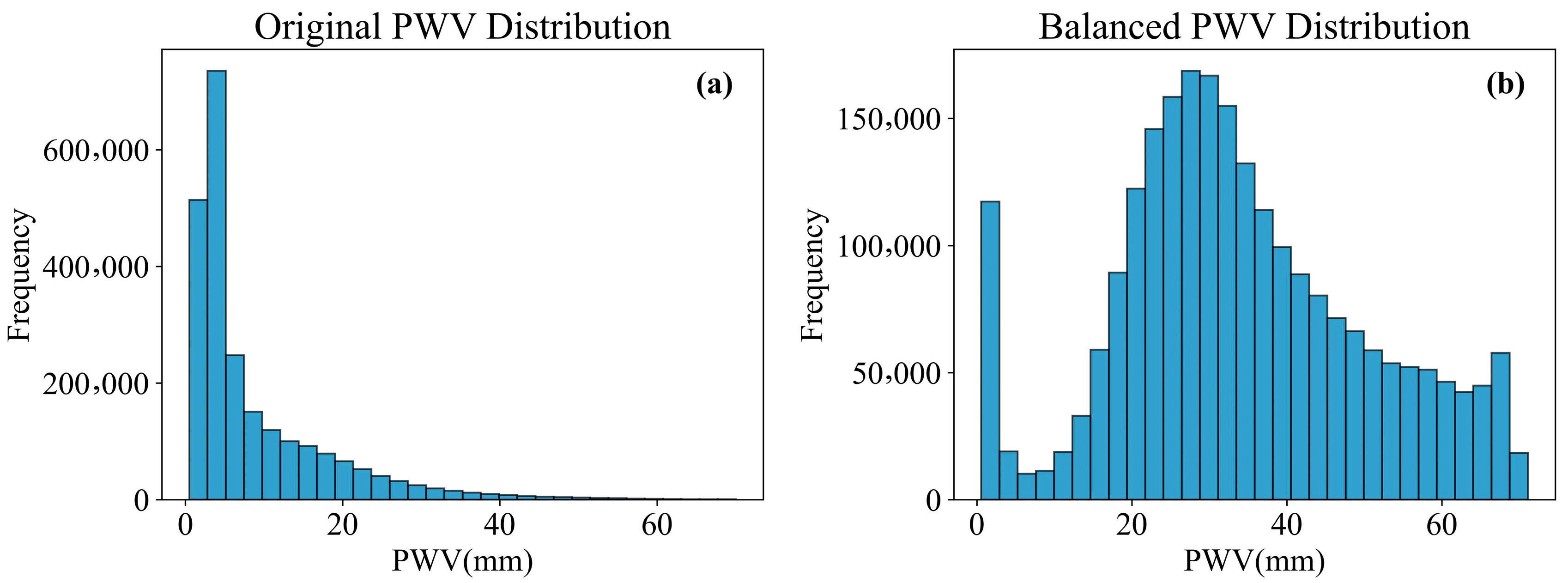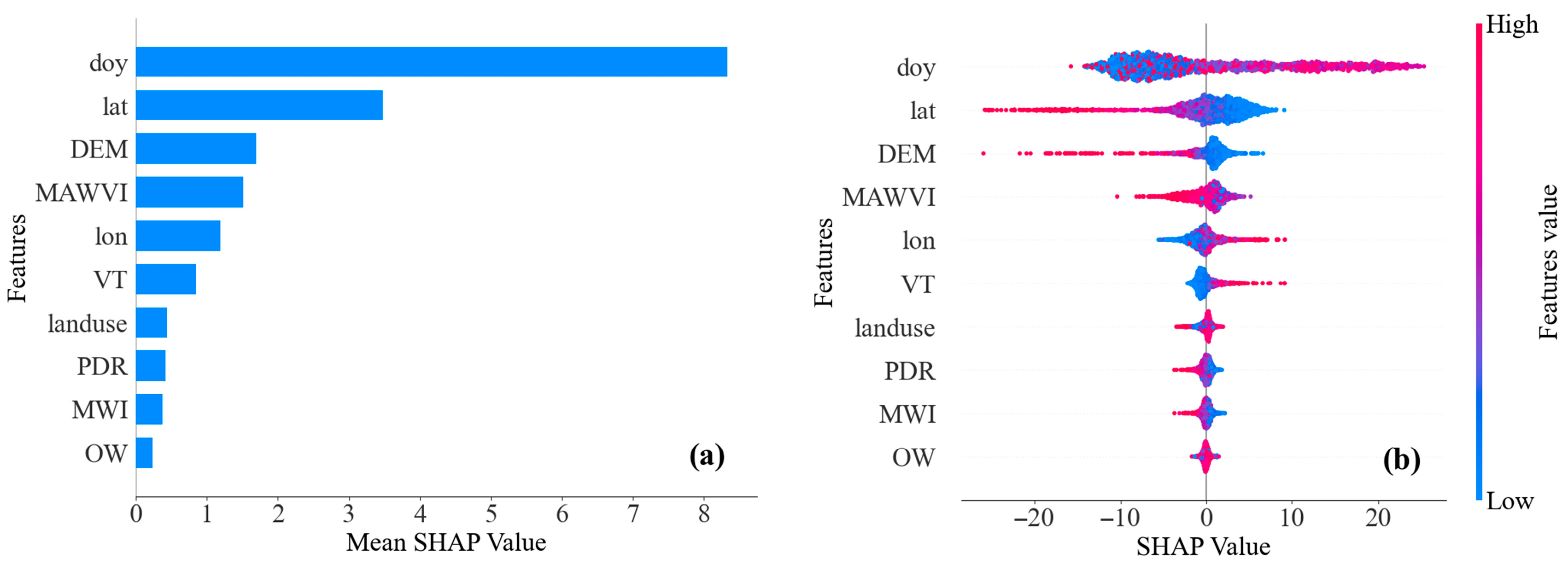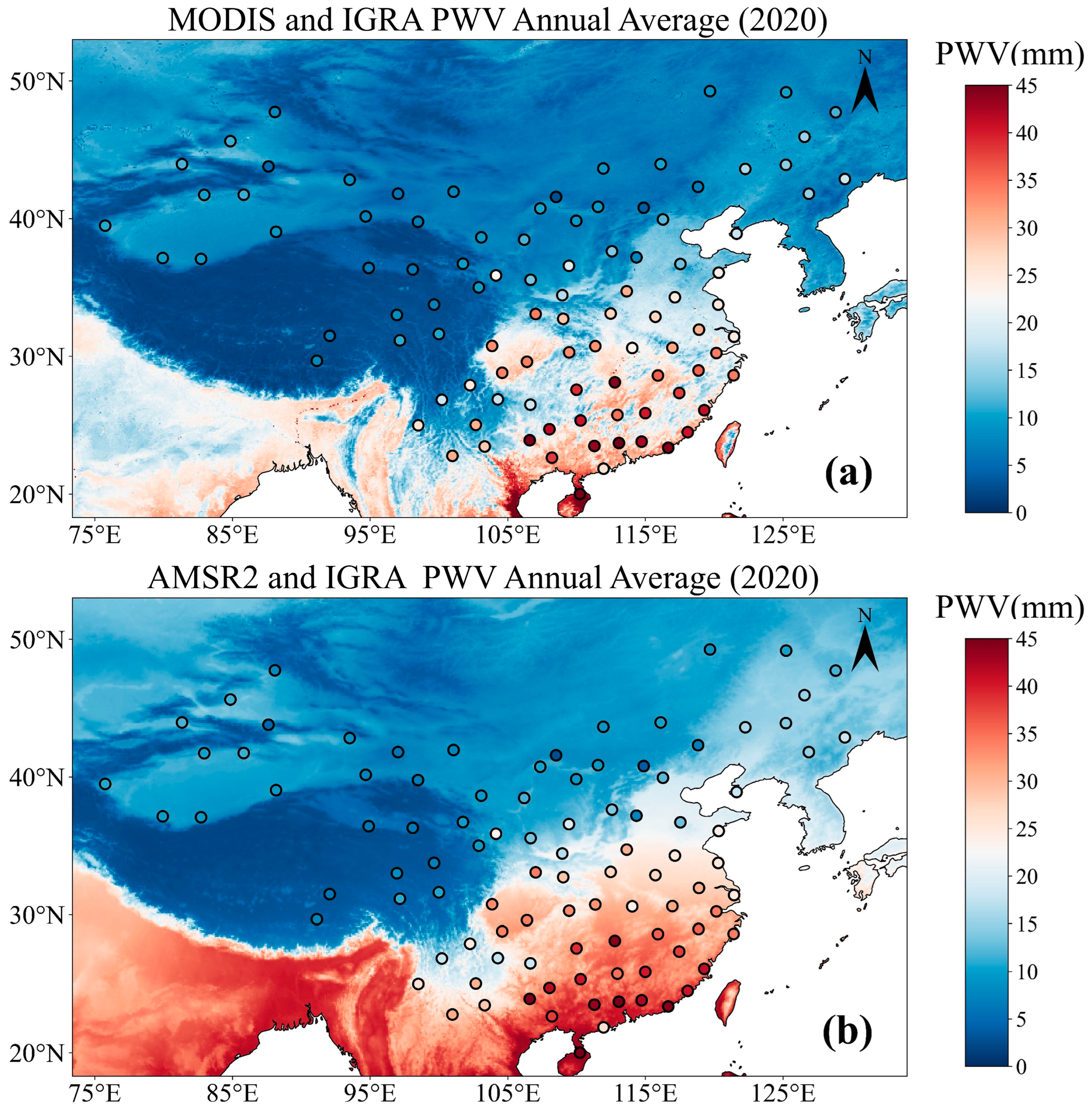All-Weather Precipitable Water Vapor Retrieval over Land Using Integrated Near-Infrared and Microwave Satellite Observations
Abstract
1. Introduction
2. Datasets
2.1. Microwave Brightness Temperature Datasets
2.2. Atmosphere Datasets
2.2.1. MODIS MCD19A2 Water Vapor
2.2.2. IGRA Radiosonde
2.3. Land Surface Datasets
2.3.1. MODIS Land Use
2.3.2. NOAA DEM
3. Methods
3.1. Training Sample Balance
3.2. Ensemble Algorithm
3.3. Model Training
3.4. SHAP (SHapley Additive exPlanations)
3.5. Evaluation Methods
4. Results
4.1. Model Training and Validation
4.2. Features Contribution Analysis with SHAP
4.3. Validation of PWV Retrieval Products with IGRA
4.4. PWV Retrieval Products Spatial Pattern Analysis
4.5. PWV Retrieval Products Temporal Variability Analysis
5. Discussions
6. Conclusions
- (1)
- By leveraging the complementary strengths of IR and MW data, the proposed approach addresses the limitations of traditional methods. While IR-based MODIS products suffer from cloud contamination, MW data enable cloud-penetrating capabilities, albeit at lower spatial resolution. The integration of spatiotemporal features and multi-source datasets (e.g., AMSR-2 brightness temperature, MODIS land surface variables, and ERA5 reanalysis) through ensemble learning models effectively bridges these gaps, achieving spatially continuous PWV estimates under all weather conditions.
- (2)
- Among the three evaluated ensemble models—Enhanced Random Trees (ERT), XGBoost, and Gradient Boosting Regression Trees (GBRT)—ERT demonstrated superior performance, achieving an R2 of 0.99, RMSE of 1.41 mm, and MAE of 0.44 mm during training. Validation against IGRA radiosonde observations confirmed high accuracy, with the ascending orbit model achieving R = 0.96 and RMSE/MAE values of 5.65/3.91, while the descending orbit model showed R = 0.95 with RMSE/MAE values of 5.68/3.95.
- (3)
- The retrieved PWV product exhibits a distinct latitudinal gradient and seasonal variability, aligning with physical expectations. Compared to MODIS, which suffers from cloud-induced data gaps, the proposed method provides seamless coverage, particularly in regions like southern China, where cloud cover is frequent. Temporal analysis across four East Asian climate zones further validated the model’s robustness, with correlation coefficients exceeding 0.88 and consistent seasonal trends.
Author Contributions
Funding
Data Availability Statement
Acknowledgments
Conflicts of Interest
References
- Manabe, S.; Wetherald, R.T. Thermal Equilibrium of the Atmosphere with a Given Distribution of Relative Humidity. J. Atmos. Sci. 1967, 24, 241–259. [Google Scholar] [CrossRef]
- Shine, K.P.; Byrom, R.E.; Checa-Garcia, R. Separating the Shortwave and Longwave Components of Greenhouse Gas Radiative Forcing. Atmos. Sci. Lett. 2022, 23, e1116. [Google Scholar] [CrossRef]
- Koll, D.D.B.; Cronin, T.W. Earth’s Outgoing Longwave Radiation Linear Due to H2O Greenhouse Effect. Proc. Natl. Acad. Sci. USA 2018, 115, 10293–10298. [Google Scholar] [CrossRef]
- Soden, B.J.; Held, I.M. An Assessment of Climate Feedbacks in Coupled Ocean–Atmosphere Models. J. Clim. 2006, 19, 3354–3360. [Google Scholar] [CrossRef]
- Dessler, A.E.; Schoeberl, M.R.; Wang, T.; Davis, S.M.; Rosenlof, K.H. Stratospheric Water Vapor Feedback. Proc. Natl. Acad. Sci. USA 2013, 110, 18087–18091. [Google Scholar] [CrossRef]
- Hodnebrog, Ø.; Myhre, G.; Samset, B.H.; Alterskjær, K.; Andrews, T.; Boucher, O.; Faluvegi, G.; Fläschner, D.; Forster, P.M.; Kasoar, M.; et al. Water Vapour Adjustments and Responses Differ between Climate Drivers. Atmos. Chem. Phys. 2019, 19, 12887–12899. [Google Scholar] [CrossRef]
- Trenberth, K.E.; Fasullo, J.T.; Mackaro, J. Atmospheric Moisture Transports from Ocean to Land and Global Energy Flows in Reanalyses. J. Clim. 2011, 24, 4907–4924. [Google Scholar] [CrossRef]
- Huntington, T.G. Evidence for Intensification of the Global Water Cycle: Review and Synthesis. J. Hydrol. 2006, 319, 83–95. [Google Scholar] [CrossRef]
- Allan, R.P.; Barlow, M.; Byrne, M.P.; Cherchi, A.; Douville, H.; Fowler, H.J.; Gan, T.Y.; Pendergrass, A.G.; Rosenfeld, D.; Swann, A.L.S.; et al. Advances in Understanding Large-Scale Responses of the Water Cycle to Climate Change. Ann. N. Y. Acad. Sci. 2020, 1472, 49–75. [Google Scholar] [CrossRef]
- Fowler, H.J.; Lenderink, G.; Prein, A.F.; Westra, S.; Allan, R.P.; Ban, N.; Barbero, R.; Berg, P.; Blenkinsop, S.; Do, H.X.; et al. Anthropogenic Intensification of Short-Duration Rainfall Extremes. Nat. Rev. Earth Environ. 2021, 2, 107–122. [Google Scholar] [CrossRef]
- Papalexiou, S.M.; Montanari, A. Global and Regional Increase of Precipitation Extremes Under Global Warming. Water Resour. Res. 2019, 55, 4901–4914. [Google Scholar] [CrossRef]
- Dong, X.; Xi, B.; Crosby, K.; Long, C.N.; Stone, R.S.; Shupe, M.D. A 10 Year Climatology of Arctic Cloud Fraction and Radiative Forcing at Barrow, Alaska. J. Geophys. Res. Atmos. 2010, 115, D17. [Google Scholar] [CrossRef]
- Seemann, S.W.; Li, J.; Menzel, W.P.; Gumley, L.E. Operational Retrieval of Atmospheric Temperature, Moisture, and Ozone from MODIS Infrared Radiances. J. Appl. Meteorol. Climatol. 2003, 42, 1072–1091. [Google Scholar] [CrossRef]
- Hu, H.; Hasekamp, O.; Butz, A.; Galli, A.; Landgraf, J.; Aan de Brugh, J.; Borsdorff, T.; Scheepmaker, R.; Aben, I. The Operational Methane Retrieval Algorithm for TROPOMI. Atmos. Meas. Tech. 2016, 9, 5423–5440. [Google Scholar] [CrossRef]
- Li, Z.-L.; Tang, B.-H.; Wu, H.; Ren, H.; Yan, G.; Wan, Z.; Trigo, I.F.; Sobrino, J.A. Satellite-Derived Land Surface Temperature: Current Status and Perspectives. Remote Sens. Environ. 2013, 131, 14–37. [Google Scholar] [CrossRef]
- Julien, Y.; Sobrino, J.A.; Mattar, C.; Jiménez-Muñoz, J.C. Near-Real-Time Estimation of Water Vapor Column from MSG-SEVIRI Thermal Infrared Bands: Implications for Land Surface Temperature Retrieval. IEEE Trans. Geosci. Remote Sens. 2015, 53, 4231–4237. [Google Scholar] [CrossRef]
- King, M.D.; Kaufman, Y.J.; Menzel, W.P.; Tanre, D. Remote Sensing of Cloud, Aerosol, and Water Vapor Properties from the Moderate Resolution Imaging Spectrometer (MODIS). IEEE Trans. Geosci. Remote Sens. 1992, 30, 2–27. [Google Scholar] [CrossRef]
- Wang, M.; Lv, Z.; Wu, W.; Li, D.; Zhang, R.; Sun, C. Multiscale Spatiotemporal Variations of GNSS-Derived Precipitable Water Vapor over Yunnan. Remote Sens. 2024, 16, 412. [Google Scholar] [CrossRef]
- Zhang, Q.; Ye, J.; Zhang, S.; Han, F. Precipitable Water Vapor Retrieval and Analysis by Multiple Data Sources: Ground-Based GNSS, Radio Occultation, Radiosonde, Microwave Satellite, and NWP Reanalysis Data. J. Sens. 2018, 2018, 3428303. [Google Scholar] [CrossRef]
- Ding, J.; Chen, J.; Tang, W.; Song, Z. Spatial–Temporal Variability of Global GNSS-Derived Precipitable Water Vapor (1994–2020) and Climate Implications. Remote Sens. 2022, 14, 3493. [Google Scholar] [CrossRef]
- Vömel, H.; David, D.E.; Smith, K. Accuracy of Tropospheric and Stratospheric Water Vapor Measurements by the Cryogenic Frost Point Hygrometer: Instrumental Details and Observations. J. Geophys. Res. Atmos. 2007, 112, D8. [Google Scholar] [CrossRef]
- Bevis, M.; Businger, S.; Herring, T.A.; Rocken, C.; Anthes, R.A.; Ware, R.H. GPS Meteorology: Remote Sensing of Atmospheric Water Vapor Using the Global Positioning System. J. Geophys. Res. Atmos. 1992, 97, 15787–15801. [Google Scholar] [CrossRef]
- Bevis, M.; Businger, S.; Chiswell, S.; Herring, T.A.; Anthes, R.A.; Rocken, C.; Ware, R.H. GPS Meteorology: Mapping Zenith Wet Delays onto Precipitable Water. J. Appl. Meteorol. Climatol. 1994, 33, 379–386. [Google Scholar] [CrossRef]
- Kaufman, Y.J.; Gao, B.-C. Remote Sensing of Water Vapor in the near IR from EOS/MODIS. IEEE Trans. Geosci. Remote Sens. 1992, 30, 871–884. [Google Scholar] [CrossRef]
- Gao, B.-C.; Kaufman, Y.J. Water Vapor Retrievals Using Moderate Resolution Imaging Spectroradiometer (MODIS) near-Infrared Channels. J. Geophys. Res. Atmos. 2003, 108, D13. [Google Scholar] [CrossRef]
- Xia, X.; Fu, D.; Shao, W.; Jiang, R.; Wu, S.; Zhang, P.; Yang, D.; Xia, X. Retrieving Precipitable Water Vapor Over Land from Satellite Passive Microwave Radiometer Measurements Using Automated Machine Learning. Geophys. Res. Lett. 2023, 50, e2023GL105197. [Google Scholar] [CrossRef]
- He, J.; Liu, Z. Water Vapor Retrieval from MODIS NIR Channels Using Ground-Based GPS Data. IEEE Trans. Geosci. Remote Sens. 2020, 58, 3726–3737. [Google Scholar] [CrossRef]
- Susskind, J.; Blaisdell, J.M.; Iredell, L. Improved Methodology for Surface and Atmospheric Soundings, Error Estimates, and Quality Control Procedures: The Atmospheric Infrared Sounder Science Team Version-6 Retrieval Algorithm. J. Appl. Remote Sens. 2014, 8, 084994. [Google Scholar] [CrossRef]
- Irion, F.W.; Kahn, B.H.; Schreier, M.M.; Fetzer, E.J.; Fishbein, E.; Fu, D.; Kalmus, P.; Wilson, R.C.; Wong, S.; Yue, Q. Single-Footprint Retrievals of Temperature, Water Vapor and Cloud Properties from AIRS. Atmos. Meas. Tech. 2018, 11, 971–995. [Google Scholar] [CrossRef]
- Alvarado, M.J.; Payne, V.H.; Mlawer, E.J.; Uymin, G.; Shephard, M.W.; Cady-Pereira, K.E.; Delamere, J.S.; Moncet, J.-L. Performance of the Line-By-Line Radiative Transfer Model (LBLRTM) for Temperature, Water Vapor, and Trace Gas Retrievals: Recent Updates Evaluated with IASI Case Studies. Atmos. Chem. Phys. 2013, 13, 6687–6711. [Google Scholar] [CrossRef]
- Divakarla, M.; Gambacorta, A.; Barnet, C.; Goldberg, M.; Maddy, E.; King, T.; Wolf, W.; Nalli, N.; Zhang, K.; Xie, H. Validation of IASI Temperature and Water Vapor Retrievals with Global Radiosonde Measurements and Model Forecasts. In Proceedings of the Imaging and Applied Optics, Toronto, ON, Canada, 10–14 July 2011; Optica Publishing Group: Washington, DC, USA, 2011; p. JWA25. [Google Scholar]
- Feng, J.; Huang, Y. Cloud-Assisted Retrieval of Lower-Stratospheric Water Vapor from Nadir-View Satellite Measurements. J. Atmos. Ocean. Technol. 2018, 35, 541–553. [Google Scholar] [CrossRef]
- Wang, Y.; Shi, J.; Wang, H.; Feng, W.; Wang, Y. Physical Statistical Algorithm for Precipitable Water Vapor Inversion on Land Surface Based on Multi-Source Remotely Sensed Data. Sci. China Earth Sci. 2015, 58, 2340–2352. [Google Scholar] [CrossRef]
- Bai, J.; Lou, Y.; Zhang, W.; Zhou, Y.; Zhang, Z.; Shi, C. Assessment and Calibration of MODIS Precipitable Water Vapor Products Based on GPS Network over China. Atmos. Res. 2021, 254, 105504. [Google Scholar] [CrossRef]
- Liu, H.; Li, H.; Tang, S.; Duan, M.; Zhang, S.; Deng, X.; Hu, J. A Physical Algorithm for Precipitable Water Vapour Retrieval over Land Using Passive Microwave Observations. Int. J. Remote Sens. 2020, 41, 6288–6306. [Google Scholar] [CrossRef]
- Liu, Q.; Cao, C.; Grassotti, C.; Lee, Y.-K. How Can Microwave Observations at 23.8 GHz Help in Acquiring Water Vapor in the Atmosphere over Land? Remote Sens. 2021, 13, 489. [Google Scholar] [CrossRef]
- Du, B.; Ji, D.; Shi, J.; Wang, Y.; Lei, T.; Zhang, P.; Letu, H. The Retrieval of Total Precipitable Water over Global Land Based on FY-3D/MWRI Data. Remote Sens. 2020, 12, 1508. [Google Scholar] [CrossRef]
- Matzler, C.; Morland, J. Refined Physical Retrieval of Integrated Water Vapor and Cloud Liquid for Microwave Radiometer Data. IEEE Trans. Geosci. Remote Sens. 2009, 47, 1585–1594. [Google Scholar] [CrossRef]
- Ji, D.; Shi, J.; Xiong, C.; Wang, T.; Zhang, Y. A Total Precipitable Water Retrieval Method over Land Using the Combination of Passive Microwave and Optical Remote Sensing. Remote Sens. Environ. 2017, 191, 313–327. [Google Scholar] [CrossRef]
- Ji, D.; Shi, J.; Letu, H.; Li, W.; Zhang, H.; Shang, H. A Total Precipitable Water Product and Its Trend Analysis in Recent Years Based on Passive Microwave Radiometers. IEEE J. Sel. Top. Appl. Earth Obs. Remote Sens. 2021, 14, 7324–7335. [Google Scholar] [CrossRef]
- Xu, J.; Liu, Z. Machine Learning-Based Retrieval of Total Column Water Vapor over Land Using GMI-Sensed Passive Microwave Measurements. GIScience Remote Sens. 2024, 61, 2385180. [Google Scholar] [CrossRef]
- Liu, Y.; Wang, X.; Zhou, Y.; Rahman, A.U. Precipitable Water Vapor Retrieved from Fy-3g/Mwri-Rm Observations Using Machine Learning Models. Adv. Space Res. 2024, 76, 1955–1969. [Google Scholar] [CrossRef]
- Gao, Z.; Jiang, N.; Xu, Y.; Xu, T.; Liu, Y. Precipitable Water Vapor Retrieval Over Land from GCOM-W/AMSR2 Based on a New Integrated Method. IEEE Trans. Geosci. Remote Sens. 2022, 60, 5302912. [Google Scholar] [CrossRef]
- Jiang, N.; Xu, Y.; Xu, T.; Li, S.; Gao, Z. Land Water Vapor Retrieval for AMSR2 Using a Deep Learning Method. IEEE Trans. Geosci. Remote Sens. 2022, 60, 5803011. [Google Scholar] [CrossRef]
- Gao, Z.; Jiang, N.; Xu, Y.; Xu, T.; Zeng, R.; Guo, A.; Wu, Y. A Spatial PWV Retrieval Model Over Land for GCOM-W/AMSR2 Using Neural Network Method: A Case in the Western United States. IEEE J. Sel. Top. Appl. Earth Obs. Remote Sens. 2023, 16, 2954–2962. [Google Scholar] [CrossRef]
- Berg, W.; Kroodsma, R.; Kummerow, C.D.; McKague, D.S. Fundamental Climate Data Records of Microwave Brightness Temperatures. Remote Sens. 2018, 10, 1306. [Google Scholar] [CrossRef]
- Berg, W.; Bilanow, S.; Chen, R.; Datta, S.; Draper, D.; Ebrahimi, H.; Farrar, S.; Jones, W.L.; Kroodsma, R.; McKague, D.; et al. Intercalibration of the GPM Microwave Radiometer Constellation. J. Atmos. Ocean. Technol. 2016, 33, 2639–2654. [Google Scholar] [CrossRef]
- Lyapustin, A.; Wang, Y.; Korkin, S.; Huang, D. MODIS Collection 6 MAIAC Algorithm. Atmos. Meas. Tech. 2018, 11, 5741–5765. [Google Scholar] [CrossRef]
- Durre, I.; Vose, R.S.; Wuertz, D.B. Overview of the Integrated Global Radiosonde Archive. J. Clim. 2006, 19, 53–68. [Google Scholar] [CrossRef]
- Durre, I.; Vose, R.S.; Wuertz, D.B. Robust Automated Quality Assurance of Radiosonde Temperatures. J. Appl. Meteorol. Climatol. 2008, 47, 2081–2095. [Google Scholar] [CrossRef]
- Geurts, P.; Ernst, D.; Wehenkel, L. Extremely Randomized Trees. Mach. Learn. 2006, 63, 3–42. [Google Scholar] [CrossRef]
- Friedman, J.H. Greedy Function Approximation: A Gradient Boosting Machine. Ann. Stat. 2001, 29, 1189–1232. [Google Scholar] [CrossRef]
- Chen, T.; Guestrin, C. XGBoost: A Scalable Tree Boosting System. In Proceedings of the 22nd ACM SIGKDD International Conference on Knowledge Discovery and Data Mining, San Francisco, CA, USA, 13–17 August 2016; Association for Computing Machinery: New York, NY, USA, 2016; pp. 785–794. [Google Scholar]
- Jones, L.A.; Ferguson, C.R.; Kimball, J.S.; Zhang, K.; Chan, S.T.K.; McDonald, K.C.; Njoku, E.G.; Wood, E.F. Satellite Microwave Remote Sensing of Daily Land Surface Air Temperature Minima and Maxima from AMSR-E. IEEE J. Sel. Top. Appl. Earth Obs. Remote Sens. 2010, 3, 111–123. [Google Scholar] [CrossRef]
- Shi, J.; Jackson, T.; Tao, J.; Du, J.; Bindlish, R.; Lu, L.; Chen, K.S. Microwave Vegetation Indices for Short Vegetation Covers from Satellite Passive Microwave Sensor AMSR-E. Remote Sens. Environ. 2008, 112, 4285–4300. [Google Scholar] [CrossRef]
- Deeter, M.N. A New Satellite Retrieval Method for Precipitable Water Vapor over Land and Ocean. Geophys. Res. Lett. 2007, 34, 2. [Google Scholar] [CrossRef]
- Sun, Q.; Ji, D.; Letu, H.; Ni, X.; Zhang, H.; Wang, Y.; Li, B.; Shi, J. A Method for Estimating High Spatial Resolution Total Precipitable Water in All-Weather Condition by Fusing Satellite near-Infrared and Microwave Observations. Remote Sens. Environ. 2024, 302, 113952. [Google Scholar] [CrossRef]
- Lundberg, S.M.; Lee, S.-I. A Unified Approach to Interpreting Model Predictions. In Proceedings of the Proceedings of the 31st International Conference on Neural Information Processing Systems, Long Beach, CA, USA, 4–9 December 2017; Curran Associates Inc.: Red Hook, NY, USA, 2017; pp. 4768–4777. [Google Scholar]
- Lundberg, S.M.; Erion, G.G.; Lee, S.-I. Consistent Individualized Feature Attribution for Tree Ensembles. arXiv 2019, arXiv:1802.03888. [Google Scholar]
- Tu, J.; Lu, E. Relative Importance of Water Vapor and Air Temperature in the Interannual Variation of the Seasonal Precipitation: A Comparison of the Physical and Statistical Methods. Clim. Dyn. 2020, 54, 3655–3670. [Google Scholar] [CrossRef]
- Kelsey, V.; Riley, S.; Minschwaner, K. Atmospheric Precipitable Water Vapor and Its Correlation with Clear-Sky Infrared Temperature Observations. Atmos. Meas. Tech. 2022, 15, 1563–1576. [Google Scholar] [CrossRef]
- Allan, R.P.; Willett, K.M.; John, V.O.; Trent, T. Global Changes in Water Vapor 1979–2020. J. Geophys. Res. Atmos. 2022, 127, e2022JD036728. [Google Scholar] [CrossRef]
- Zhang, Y.; Ma, N.; Park, H.; Walsh, J.E.; Zhang, K. Evaporation Processes and Changes Over the Northern Regions. In Arctic Hydrology, Permafrost and Ecosystems; Yang, D., Kane, D.L., Eds.; Springer International Publishing: Cham, Switzerland, 2021; pp. 101–131. ISBN 978-3-030-50930-9. [Google Scholar]
- Piao, J.; Chen, W.; Chen, S.; Gong, H.; Zhang, Q. Summer Water Vapor Sources in Northeast Asia and East Siberia Revealed by a Moisture-Tracing Atmospheric Model. J. Clim. 2020, 33, 3883–3899. [Google Scholar] [CrossRef]
- Lou, H.; Zhang, J.; Yang, S.; Cai, M.; Ren, X.; Luo, Y.; Li, C. Exploring the Relationships of Atmospheric Water Vapor Contents and Different Land Surfaces in a Complex Terrain Area by Using Doppler Radar. Atmosphere 2021, 12, 528. [Google Scholar] [CrossRef]
- Yang, Y.; Zhao, C.; Fan, H. Spatiotemporal Distributions of Cloud Properties over China Based on Himawari-8 Advanced Himawari Imager Data. Atmos. Res. 2020, 240, 104927. [Google Scholar] [CrossRef]
- Meza, A.; Mendoza, L.; Natali, M.P.; Bianchi, C.; Fernández, L. Diurnal Variation of Precipitable Water Vapor over Central and South America. Geod. Geodyn. 2020, 11, 426–441. [Google Scholar] [CrossRef]
- Chu, Q.; Wang, Q.; Feng, G.; Jia, Z.; Liu, G. Roles of Water Vapor Sources and Transport in the Intraseasonal and Interannual Variation in the Peak Monsoon Rainfall over East China. Clim. Dyn. 2021, 57, 2153–2170. [Google Scholar] [CrossRef]
- Du, J.; Kimball, J.S.; Jones, L.A. Satellite Microwave Retrieval of Total Precipitable Water Vapor and Surface Air Temperature Over Land from AMSR2. IEEE Trans. Geosci. Remote Sens. 2015, 53, 2520–2531. [Google Scholar] [CrossRef]
- Martins, V.S.; Lyapustin, A.; Wang, Y.; Giles, D.M.; Smirnov, A.; Slutsker, I.; Korkin, S. Global Validation of Columnar Water Vapor Derived from EOS MODIS-MAIAC Algorithm against the Ground-Based AERONET Observations. Atmos. Res. 2019, 225, 181–192. [Google Scholar] [CrossRef]
- Aires, F.; Prigent, C.; Rossow, W.B.; Rothstein, M. A New Neural Network Approach Including First Guess for Retrieval of Atmospheric Water Vapor, Cloud Liquid Water Path, Surface Temperature, and Emissivities over Land from Satellite Microwave Observations. J. Geophys. Res. Atmos. 2001, 106, 14887–14907. [Google Scholar] [CrossRef]
- Prakash, S.; Norouzi, H.; Azarderakhsh, M.; Blake, R.; Prigent, C.; Khanbilvardi, R. Estimation of Consistent Global Microwave Land Surface Emissivity from AMSR-E and AMSR2 Observations. J. Appl. Meteorol. Climatol. 2018, 57, 907–919. [Google Scholar] [CrossRef]
- Xu, R.; Pan, Z.; Han, Y.; Zheng, W.; Wu, S. Surface Properties of Global Land Surface Microwave Emissivity Derived from FY-3D/MWRI Measurements. Sensors 2023, 23, 5534. [Google Scholar] [CrossRef] [PubMed]
- Turner, D.D.; Clough, S.A.; Liljegren, J.C.; Clothiaux, E.E.; Cady-Pereira, K.E.; Gaustad, K.L. Retrieving Liquid Wat0er Path and Precipitable Water Vapor from the Atmospheric Radiation Measurement (ARM) Microwave Radiometers. IEEE Trans. Geosci. Remote Sens. 2007, 45, 3680–3690. [Google Scholar] [CrossRef]











| Datasets | Temporal Resolution | Spatial Resolution | Data Sources | |
|---|---|---|---|---|
| Band datasets | AMSR2 Microwave Brightness Temperature | 1.5 h | 10 km | National Aeronautics and Space Administration Earth Data |
| Atmosphere datasets | MODIS MCD19A2 PWV | 1 day | 1 km | Google Earth Engine |
| IGRA Radiosonde | day | - | National Oceanic and Atmospheric Administration National Centers for Environmental Information | |
| Land surface datasets | MODIS Land use | 1 year | 500 m | Google Earth Engine |
| NOAA DEM | - | 1 km | Same as IGRA Radiosonde |
| Feature Class | Feature Name | Formula | Temporal Resolution | Spatial Resolution | Explanation |
|---|---|---|---|---|---|
| Spatiotemporal features | Lon | Longitude | / | / | Longitude of each location |
| Lat | Latitude | / | / | Latitude of each location | |
| Doy (Day of the year) | / | / | Doy of each location | ||
| Microwave band features | VT (Vegetation Transmissivity) | 1.5 h | 10 km | Determining vegetable transmissivity [54] | |
| OW (Open Water Fraction) | Sensitive to open water [54] | ||||
| MVI (Microwave Vegetable Index) | Sensitive to surface vegetable [55] | ||||
| MAWVI (Microwave Water Vapor Index) | Sensitive to water vapor in atmosphere [56] | ||||
| PDR89/36.5 | Sensitive to water vapor in atmosphere [57] | ||||
| Other features | DEM | / | / | 1 km | Affecting the path of the microwave signal |
| Land use | / | year | 500 m | Distinguish different surface types |
| Parameters | n_estimators | max_depth | min_samples_split | min_samples_leaf | Gamma | |
|---|---|---|---|---|---|---|
| Models | ||||||
| ERT | 540 | 11 | 15 | 9 | / | |
| XGBoost | 610 | 13 | 17 | / | 0.2 | |
| GBRT | 570 | 14 | 12 | 7 | / | |
Disclaimer/Publisher’s Note: The statements, opinions and data contained in all publications are solely those of the individual author(s) and contributor(s) and not of MDPI and/or the editor(s). MDPI and/or the editor(s) disclaim responsibility for any injury to people or property resulting from any ideas, methods, instructions or products referred to in the content. |
© 2025 by the authors. Licensee MDPI, Basel, Switzerland. This article is an open access article distributed under the terms and conditions of the Creative Commons Attribution (CC BY) license (https://creativecommons.org/licenses/by/4.0/).
Share and Cite
Song, S.; Zhu, M.; Tao, Z.; Xu, D.; Jiao, S.; Yang, W.; Wang, H.; Zhao, G. All-Weather Precipitable Water Vapor Retrieval over Land Using Integrated Near-Infrared and Microwave Satellite Observations. Remote Sens. 2025, 17, 2730. https://doi.org/10.3390/rs17152730
Song S, Zhu M, Tao Z, Xu D, Jiao S, Yang W, Wang H, Zhao G. All-Weather Precipitable Water Vapor Retrieval over Land Using Integrated Near-Infrared and Microwave Satellite Observations. Remote Sensing. 2025; 17(15):2730. https://doi.org/10.3390/rs17152730
Chicago/Turabian StyleSong, Shipeng, Mengyao Zhu, Zexing Tao, Duanyang Xu, Sunxin Jiao, Wanqing Yang, Huaxuan Wang, and Guodong Zhao. 2025. "All-Weather Precipitable Water Vapor Retrieval over Land Using Integrated Near-Infrared and Microwave Satellite Observations" Remote Sensing 17, no. 15: 2730. https://doi.org/10.3390/rs17152730
APA StyleSong, S., Zhu, M., Tao, Z., Xu, D., Jiao, S., Yang, W., Wang, H., & Zhao, G. (2025). All-Weather Precipitable Water Vapor Retrieval over Land Using Integrated Near-Infrared and Microwave Satellite Observations. Remote Sensing, 17(15), 2730. https://doi.org/10.3390/rs17152730







